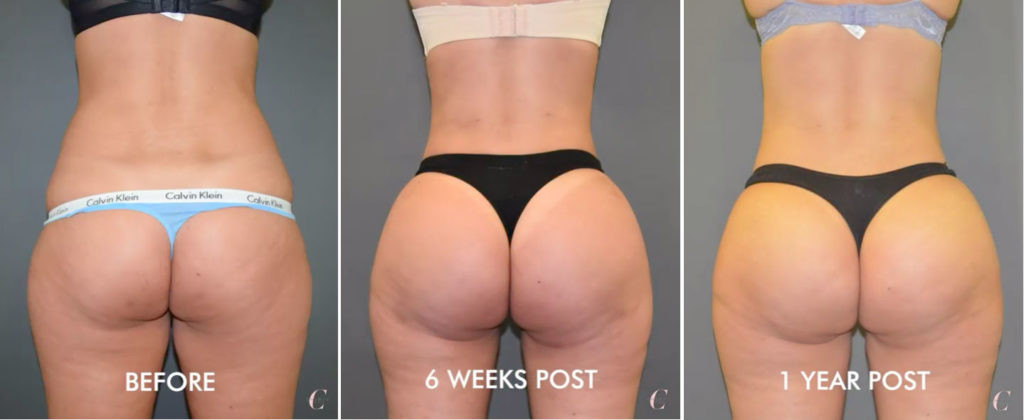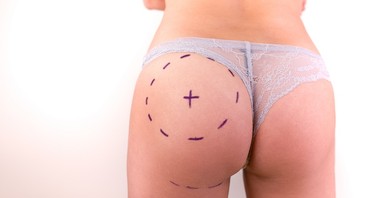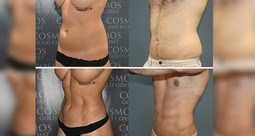How much of the fat tissue survives after having a Brazilian Butt Lift (BBL) is one of the most common questions we receive at Cosmos Aesthetics.
Not all of the fat (adipose tissue) transferred into the buttocks will survive the plastic surgery long term. The fat graft survival rate will depend on a few factors including the techniques used and the patient’s recovery.
The fat grafting procedure
The fat grafting techniques used are one of the key factors that will greatly determine the fat survival rate.
VASER LIPOSUCTION
Unwanted adipose tissue is removed from areas of the body such as the abdomen, thighs and back using Vaser Liposuction. This is a gentler approach to removing fat tissue than that of traditional liposuction methods and doesn’t destroy the adipose tissue by exposing it to heat.
FAT PURIFICATION
The extracted fat cells undergo processing to purify and separate excess fluid from the fat tissue. This process not only clears the human fat of any unwanted substances but also ensures only healthy and strong cells are used in the fat transplantation.
EXPANSION VIBRATION LIPOFILLING
Before the fat cells are reinjected into the targeted area, the adipose tissue is expanded using the advanced Expansion Vibration Lipofilling (EVL) technique of fat grafting. This helps to enhance the fat survival rate by:
- Improving the likelihood of the adipose tissue growing and persisting;
- Evenly distributing the fat cells;
- Allowing for a higher volume of grafted fat.
How much fat is re-injected into the buttocks
After the adipose tissue is purified, the fat transplantation process occurs where the fat cells are re-injected into the buttocks making a significant difference to the size and shape of the patient’s derrière.
On average, the Cosmos Aesthetics doctors will inject 1,000 – 1,200 mls of stable fat cells into each buttock cheek. In some cases, up to 1.8L of purified fat tissue will be injected into the targeted area.
How much fat survives the fat transfer
Fat grafting is a delicate process and not all of the fat cells transferred during a BBL procedure will survive.
In our experience, the fat survival rate after a BBL procedure is generally more than 80%. For example, if 1L of purified fat tissue is injected into each buttock, we’d expected to see a long-term survival of about 800 mls of fat.
While about 15-20% of fat tissue is lost during the fat transfer, enough still remains to see a significant difference and obtain the desired results of a BBL as you can see from the photos below.

Initially, swelling of the buttocks will occur causing an increase in graft volume. The results of the fat transfer will begin to stabilise after about 3 months and you’ll be able to see the real survival of the fat grafts.
Maximising your fat graft survival rates
It’s not only the experience of your doctor and the techniques used during your cosmetic and plastic surgery that influences the fat tissue survival rates. The patient’s recovery and ability to follow the post-operative recommendations will impact the longevity of the fat injection results.
Here are some tips to help maximise your fat tissue survival rates:
- Wear the dedicated compression garments as instructed;
- Avoid smoking to ensure adequate flow of blood cells and blood supply to the newly transplanted fat tissue;
- Limit drinking alcohol to ensure healthy circulation and reduce the risk of adipose tissue degradation;
- Attend all follow-up lymphatic massage appointments to reduce excess fluid and alleviate swelling;
- Avoid applying pressure to the buttock and fat grafting area to reduce the risk of fat cell death;
- Swap strenuous physical activity for light walking to limit the loss of transferred fat cells while recovering;
- Consume a nutrient-dense diet to support recovery, encourage healthy blood supply and promote fat survival.
- Maintain a healthy weight and avoid fluctuations in weight gain or loss to maintain the volume in the buttocks.
Discover more about the BBL procedure here or find out if you are a good candidate for cosmetic surgery by contacting the Cosmos Aesthetics team here or calling on 1300-138-797.






